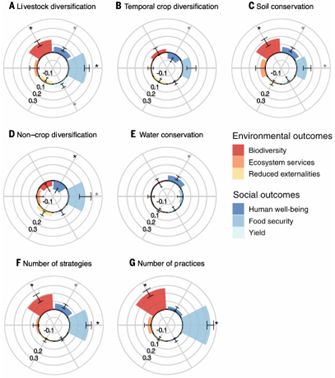April 4, 2024 | Science | Source |
Introduction: This study, conducted by an interdisciplinary group of scholars from various international agencies, investigates the simultaneous social and environmental benefits of agricultural diversification. Utilizing data from 24 studies across 11 countries and 2,655 farms, the research addresses the impact of five diversification strategies—livestock integration, crop rotation, soil conservation, non-crop plantings, and water management. It aims to fill gaps in understanding how these strategies affect biodiversity, ecosystem services, food security, and human well-being, providing insights into sustainable agriculture's role in mitigating environmental degradation.
Key findings: The study confirms that diversified agriculture improves outcomes more effectively than individual strategies. Key benefits include increased nonagricultural biodiversity and improved food security. Specific combinations, such as livestock diversification and soil conservation, were found to generate significant synergies by simultaneously enhancing biodiversity and food security. The positive effects were particularly strong when multiple strategies were combined, highlighting the interdependence of environmental and social outcomes‚Äč. Diversification improves sustainability but requires region-specific adaptations and mitigation of labor and cost trade-offs. Policymakers should provide targeted incentives combined with regulations, support multi-strategy approaches, and promote participatory research to address resource disparities and tailor practices to local contexts.

Figure | Effects of agricultural diversification on environmental and social outcomes. (A to G) Agricultural diversification strategies include livestock diversification, temporal crop diversification, soil conservation, noncrop diversification, and water conservation. Flower diagrams indicate the effects of diversification strategies on three environmental outcome variables (nonagricultural biodiversity, regulating ecosystem services, and reduced environmental externalities) and three social outcome variables (human well-being, food security, and yield). Also shown are the effects of the total number of diversification strategies (up to a total of five) and their associated diversification practices (up to a total of 23, excluding livestock diversification) applied. Effect sizes are measured in units of SD, with the black circle indicating an effect size of 0.0. The size of the flower petals is proportional to the effect size; error bars indicate ± 1 SE. Asterisks indicate statistically significant effects of diversification strategies on outcomes (gray asterisks, P < 0.00119 using Bonferroni correction for multiple comparisons; 42 estimates).





